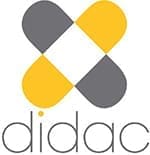Customer Service Specialist
Apprenticeship Level 3
| Occupations | |
|---|---|
| Customer service manager | ✔ |
| Customer support service supervisor | ✔ |
| Service Centre Manager | ✔ |
✔ |
|
| Level | |
|---|---|
| Level 3 - equivalent to A Level | ✔ |
| Advanced workplace skills | ✔ |
| Advanced vocational skills | ✔ |
| Advanced workplace behaviours | ✔ |
| Training Locations | |
|---|---|
| Employer's customer facing facility | ✔ |
| Getting started | |
|---|---|
| January, May & September | Starts |
| Training places subject to caseload capacity | Please enquire |
| Geographic locations - some restrictions apply | Please enquire |
| Training Access & Support | |
|---|---|
| Access Didac's eLearning Portal | ✔ |
| One-to-one training sessions | ✔ |
| Regular reviews with your trainer and employer | ✔ |
| ePortfolio - to record training & development | ✔ |
| Opportunities to improve your maths & English skills | ✔ |
| Duration | |
|---|---|
| Minimum of 12 months, typically 15months | ✔ |
| Funding - England | |
|---|---|
| Government Funding | ✔ |
| Funding Value | £4,000 |
| Employer Contributions | £500 |
| Age grants for employers - England | |
|---|---|
| Under 19 Apprentice - 3 months | £500 |
| Under 19 Apprentice - 12 months | £500 |
| Occupational Standard | |
|---|---|
| Customer Service Specialist | |
| Wales, Scotland & Northern Ireland | |
|---|---|
| Please contact us for commercial options | |
Customer Service Specialist
Apprenticeship Level 3
A professional for direct customer support
Dealing with customer queries, purchases and complaints
In this role you will be an advocate for exemplary customer service. You will frequently act as a referral point for dealing with more complex or technical customer requests, complaints, and queries. You are often an escalation point for complicated or ongoing customer problems.
As an expert in your organisation’s products and/or services, you share knowledge with your wider team and colleagues.
You gather and analyse data and customer information that influences change and improvements in service. Utilising both organisational and generic IT systems to carry out your role with an awareness of other digital technologies.
This could be in many types of environment including head offices, regional centres, contact centres, retail, webchat, service industry or any customer service point.
Whether you are leaving school or looking to change career to work in a Sales, marketing and procurement role this is a great apprenticeship standard because it provides the knowledge and skills you will need to kick-start your career.
Frequently, customer service specialist roles are a gateway to a host of career opportunities in sales, purchasing, product specialist, branch management, account management, logistics and administration.
With Didac’s training experience in customer service roles, we can create stimulating training plans to cover specialised customer-facing situations.
Click the Add to Enquiry button below to find out more by registering your interest with us. You are not committing to anything.
Specification
| Accreditation | |
|---|---|
| Delivery |
You must:
- be 16 or over
- not already be in full-time education
- live in England to qualify for Didac funded apprenticeships
You can start an apprenticeship whether you’re starting your career, want a change or you’re upskilling in your current job. You can have a previous qualification like a degree and still start an apprenticeship.
As an apprentice you’ll:
- learn and train for a specific job
- get paid and receive holiday leave
- get hands-on experience in a real job
- be given the opportunity to improve your maths and English skills
- study for at least 20% of your working hours off-the-job
- complete assessments during and at the end of your apprenticeship
- be on a career path with lots of future potential
The apprenticeship will help you develop your knowledge and skills in the following areas
Knowledge
- Business knowledge and understanding
- Customer journey knowledge
- Knowing your customers and their needs (Customer Insight)
- Customer service culture and environment awareness
Skills
- Business-focused service delivery
- Providing a positive customer experience
- Working with your customers / customer insights
- Customer service performance
- Service improvement
The apprenticeship will help you develop the following behaviours and attitude
Develop self
- Proactively keep your service, industry and best practice knowledge and skills up-to-date
- Consider personal goals related to service and take action towards achieving them
Ownership / Responsibility
- Proactively keep your service, industry and best practice knowledge and skills up-to-date
- Consider personal goals related to service and take action towards achieving them
Team Working
- Work eìectively and collaboratively with colleagues at all levels to achieve results
- Recognise colleagues as internal customers
- Share knowledge and experience with others to support colleague development
Equality
- Adopt a positive and enthusiastic attitude being open minded and able to tailor your service to each customer
- Be adaptable and flexible to your customer needs whilst continuing to work within the agreed customer service environment
Presentation
- Demonstrate brand advocacy, values and belief when dealing with customer requests to build trust, credibility and satisfaction
Ensure your personal presentation, in all forms of communication, reîects positively on your organisation’s brand
Completion of this apprenticeship will lead to eligibility to join the Institute of Customer Service as an Individual member at Professional level. Should you choose to progress on a customer service career path, you may be eligible for further professional membership including management.
You may also like…

Review Title
Please feel free to leave us a review!



Review Title
Please feel free to leave us a review!


